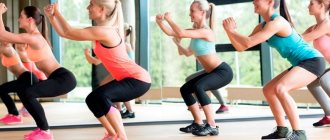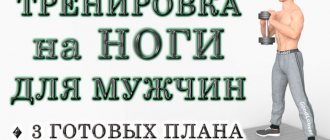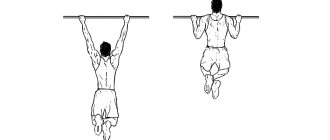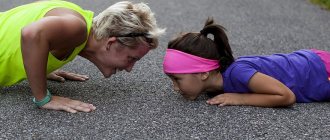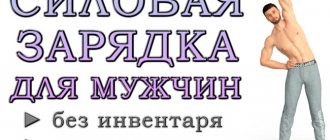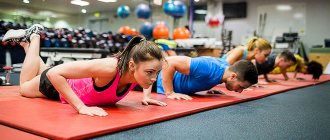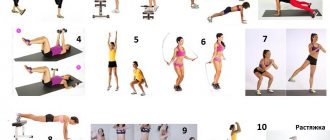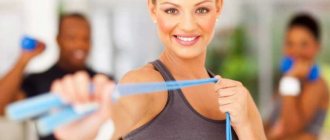The author of the Strength & Conditioning Research resource, Chris Beardsley, decided to answer the question of many trainees - is it possible to achieve maximum development of the thigh muscles through barbell squats alone. The editors of Zozhnik decided that they should not deprive their readers of such interesting information. Let's give the floor to Chris.
From time to time on the forum people ask: “What is the best way to plan a workout to develop the muscles of the lower body?” One well-known athlete gave a short recommendation: “Just squat.” But is it really possible to achieve optimal thigh muscle development by squatting alone?
What does "Just Squat" mean?
If you take this phrase literally, it could mean that all you need to develop your legs is squats and nothing else.
But some people, when they say “Just squat,” mean working all the muscles except the hamstring group (so calf curls are not excluded from the workout in this case). Sometimes this recommendation is also given by those who, in addition to squats, do deadlifts or glute bridges. In their understanding, the phrase “Just squat” refers only to the quadriceps.
Regardless of the context that is put into this recommendation, I suggest considering 2 questions:
- Are squats a good exercise for developing hamstrings?
- Are squats effective for developing all heads of the quadriceps muscle?
Partial squats (partial squats)
This type of squats has several significant positive aspects.
When performing partial squats, the load on the back and knee joints is reduced (since the angle between the hips and calves is greater).
I also saw how powerlifters used this type of squats to break through their so-called. "psycho-emotional ceiling" That moment when you are afraid to take on new weight, because... you think you can't stand it.
These squats, in such cases, come in handy.
It is best to perform them either in a Smith machine (in a power rack).
Or in regular squat racks, but with high-mounted stops that will serve as support. If something goes wrong.
Partial squat technique
It’s no different from regular squats, the only difference being that you squat not to parallel, but a little higher.
Partial squats can be performed either classic style (a little more dangerous) or sumo style (less dangerous).
Muscles of the back of the thigh: “Squat, but don’t forget about the deadlift?”
Fitness professionals know that squats are very effective for developing the quadriceps, adductor magnus and gluteus maximus muscles, but are not very effective for developing the hamstrings (Wright et al. 1999).
This is why a variety of deadlift variations (plus other exercises) are always included in a good training program to target the posterior chain muscles (those located on the back of the body)*.
To support the opinion that squats are incapable of properly loading the muscles of the hamstrings, we present the following data:
- Increasing the weight on the barbell in the squat does not increase hamstring activation , but does significantly increase quadriceps and gluteus maximus activation (Li et al. 2013).
- Lowering into a deeper squat with the same load does not increase hamstring activation , but does increase quadriceps and gluteus maximus activation much more (Gorsuch et al. 2013; Contreras et al. 2015b).
Front Squats
Or a front squat.
It’s good because it focuses the load strictly on your quadriceps and makes it much easier to maintain balance (the main weight is in front, while moving the body back).
There is a slight downside in that you have to hold your hands in an awkward position to hold the barbell, but over time you will get used to it.
Front squat technique
- We approach the squat rack (as a rule, there are limiters there, install them, they give additional confidence).
- Bring your shoulders under the bar. We cross our arms and grab the bar.
- We place the bar just below your deltoids, almost above your biceps.
- We remove the bar and take a step back.
- We strain and straighten our back. Attention: When performing front squats, your feet must be pressed to the floor ENTIRELY!!! There should be no calf raises!!!
- We keep our heads either straight or look up. This will allow us to keep our back straight at every point of the amplitude!
- We place our feet slightly wider than our shoulders, with our toes pointing forward (you can turn them outward by 15-20 degrees).
- The back is straight, the head looks straight or up, we begin to bend the legs.
- We squat either until our thighs are parallel to the floor, or slightly lower.
- WE FEEL THE CONTRACTION AND TENSION OF OUR QUADRICEPS, we begin to move upward.
- We strain our quadriceps, straight back, look up or straight, stand up, constantly thinking about how the quadriceps feel. You must feel them AT EVERY POINT OF AMPLITUDE, otherwise, otherwise, the load may not hit the target exactly, but will “spread” over the back, buttocks and other muscles.
Why do the muscles of the back surface weakly engage during squats?
If we consider this issue from a biomechanical point of view, then, most likely, weak activation of the posterior muscles during squats is due to the fact that these muscles are bi-articular. They work as both hip extensors and calf flexors.
So, when you lower yourself into a squat (flexing your hip and shin), the muscle contracts closer to the knee but stretches closer to the hip joint. Roughly speaking, its length remains almost unchanged. When you rise from a squat (extending your hip and lower leg), the opposite happens - the muscle stretches closer to the knee, but contracts near the hip joint. Again, its length remains almost unchanged. This makes the hamstrings less effective as hip extensors during squats.
You might say, “I don’t care what the research says about lack of activation, I can feel my hamstrings firing when I squat.” And, of course, I will not argue with this.
You should really feel the muscles in the back of your thigh working during squats - that's where the adductor magnus is located. This is a very large muscle that is an important hip extensor during squats. It is located next to the muscles of the back surface, so in most cases you feel its work.
Testosterone production when doing squats
The legs are the LARGEST muscle group in our body.
Performing leg exercises requires a huge amount of effort, energy and recovery capacity.
Leg training is always a HUGE STRESS for the body. After all, almost the entire body is involved in this process.
The muscles of the legs (of course), core, back, arms, etc. become tense.
Blood circulation in the lower part of the body increases, which leads to stimulation of the sex glands (in men), which then leads to the production of a huge amount of ANABOLIC HORMONES (testosterone, primarily).
Almost always, anabolic hormones are released in excess, which is enough for the restoration and growth of other parts of the body.
Especially, this is very useful for athletes who train naturally. Indeed, it is in this case (when you train without steroids and other stimulants) that the production of your OWN testosterone plays a leading role.
We must try with all our might to create a favorable anabolic background for the body to grow.
Squats and quadriceps femoris
The quadriceps consists of 4 muscles located on the front of the thigh. By the way, just recently scientists discovered a new muscle, which they called the “tensor vastus intermedius” (Grob et al. 2016).
While researchers work through updating anatomical nomenclature, we will recall the names of the four main muscles of the quadriceps:
- Vastus lateralis muscle,
- Vastus medialis muscle,
- Vastus intermedius muscle
- Rectus muscle.
Of the four muscles of the quadriceps, all except the rectus muscle are single-joint muscles, the only function of which is to extend the lower leg. The rectus femoris is a biarticular muscle that, in addition to straightening the lower leg, flexes the thigh.
Now let’s see how much, in percentage terms, the physiological* cross-sectional area of each quadriceps head occupies (as you can see, each of the 4 muscles makes a significant contribution to the total volume of the thigh):
Vastus lateralis - vastus lateralis, Vastus medialis - vastus medialis, Vastus intermedius - vastus intermedius, Rectus femoris - rectus femoris.
It makes sense that if we are looking for maximum thigh muscle development, we need to make sure that the exercises we use target all 4 heads of the quadriceps.
Smith machine squats
These squats are different in that the problem with stabilizing movements is COMPLETELY eliminated. You move along a strict trajectory dictated to you by the simulator.
This allows you to move your feet much further forward to shift the load on your gluteal muscles.
Nothing special about technology. As with most regular squats, only before starting the movement you will need to rotate the bar slightly around its axis to remove it from the hooks and begin the movement.
Before finishing the approach, you need to do the same thing, only in the opposite direction (to put the bar in place).
You can do a wide variety of exercises at Smith.
The most concentrated and one of the best exercises for the gluteal muscles is the following exercise.
Does the rectus femoris muscle grow from squats?
Squats have always been considered the best exercise for overall development of the quadriceps muscles, which has been confirmed in studies . In 1994, Signorile et al. studied the degree of electromyographic (EMG) activation of the vastus lateralis and vastus medialis muscles during squats and calf extensions in a machine. It was squats that showed higher EMG activation of the muscles studied.
A 2009 experiment (Ebben et al.) once again confirmed that in terms of development of the vastus lateralis muscle, squats are more effective than calf extensions, as well as deadlifts and step-ups.
On the other hand, as another experiment from the same year showed (Ebben et al.), during calf extension in the machine, there is a higher activation of the rectus femoris muscle compared to squats.
A very important study was conducted in 2015 (Fonseca et al.), in which 2 groups of participants trained in different patterns over a long period. One part of the subjects only squatted, while the other did several exercises: squats, leg presses, deadlifts and lunges. The group that trained with variety had hypertrophy in all 4 heads of the quadriceps, including the rectus femoris. In those who only squatted, only 3 single-joint heads of the quadriceps increased in volume.
Again, the lack of hypertrophy of the rectus femoris in squatters is due to the fact that it is both a hip flexor and an extensor of the leg.
As you lower into the squat (flexing the hip and shin), the rectus muscle stretches closer to the knee but contracts closer to the hip joint. As is the case with the muscles of the back of the thigh, its length remains almost unchanged. When moving upward from a squat (the thigh and lower leg extend), the rectus muscle contracts at the knee, but stretches near the hip joint. The result is the same - in the direction of movement its length practically does not change. It turns out that the rectus femoris muscle is very weakly involved in the work during squats.
As already mentioned, the degree of activation of the rectus femoris muscle is much higher during leg extension in the simulator.
The rectus muscle appears to increase in size more readily when performing this single-joint exercise when compared to the rest of the quadriceps heads (Ema et al. 2013).
This is how hypertrophy of the quadriceps heads occurs after systematically performing calf extensions.
Change in the anatomical cross-sectional area of the quadriceps muscles after calf extensions in the simulator:
From left to right – vastus lateralis, vastus medialis, vastus intermedius and rectus femoris.
Proximal (proximal) – located closer to the place of attachment of the limb to the body (in our case, the muscle section closer to the hip joint).
Distal (distal) - located further from the place of attachment of the limb to the body (in our case, closer to the knee).
Apparently, the rectus femoris muscle works most actively in exercises where simultaneous (and relatively equal in amplitude) flexion of the thigh and lower leg does not occur.
Leg training program for beginners
A leg muscle training program might look like this:
- Barbell squats: 15, 12, 10, 8, 6.
- Platform press: 10, 8, 8, 8.
- Leg extension on the block: 3 x 10 or 12.
- Lying leg curls on a block: 15, 12, 10, 8.
- Deadlift on straight legs: 12, 10, 10.
Squats
The first exercise is barbell squats. It is believed that you have done a good warm-up and your muscles are ready for hard work. The last and penultimate time is done to failure, that is, to such a state when the next repetition is no longer possible without the help of a partner.
Remove the barbell from the racks and place it on your shoulders. Feet approximately shoulder width apart. After taking a deep breath, begin to squat. Make sure your back is straight and not rounded, your pelvis is tilted back, and your gaze is directed straight ahead.
You should lower yourself to a level where your thighs become parallel to the floor or slightly lower. It must be remembered that squats that are too deep have a strong impact on the gluteal muscles. In this case, there is a high probability of injury to the knees and lower back. See the differences between barbell squats in bodybuilding and powerlifting here.
Leg press
Legs are a huge muscle mass; it is difficult to “break” them with one, even such a heavy exercise as squats. Therefore, the second exercise is the leg press. This is considered the best option.
In the starting position, the legs are shoulder-width apart. The weight drops to the point where the angle between the shin and thigh becomes straight. In this case, all the force of the upward movement must be put into the heels, and not into the toes.
Leg extensions
The third exercise is extensions, which allow you to pump your quadriceps to failure. Here the time between approaches should not exceed 1.5 minutes.
In the starting position, the legs are bent at a right angle. A smaller angle is dangerous for the knees. By changing the position of your feet, you can redistribute the load on your quadriceps. When the toes are turned outward, the inner side of the quadriceps is loaded, and the outer side is loaded inward.
Leg Curls
Now is the time to move on to curls. Do 4 sets at 1.5 minute intervals.
When bending your legs, you must ensure that your pelvis does not come off the bench and your toes are extended throughout the entire exercise. The exercise is performed cleanly and under control without jerking or jerking. It is possible to shift the emphasis to the negative phase of the exercise.
Hack - squats
When performing squats, you need to make sure that your knees are not in front of your toes and that your back is pressed tightly against the pad of the machine.
Next comes the straight-legged deadlift or Romanian deadlift, which aims to work the upper thigh.
Deadlift on straight legs
This exercise perfectly develops the upper hamstrings, as well as the gluteal muscles. In the starting position, the distance between the feet is 10-15 cm, the legs are slightly bent at the knees. During the exercise, keep your back extremely straight. From the bottom position, the bar rises due to the contraction of the biceps of the thighs and buttocks, the angle of bend of the knees does not change.
Among people actively training with iron, there are very few who can boast of well-developed quadriceps and hamstrings. As a rule, beginners’ favorite muscle groups are the arms and chest; they even forget about the shoulders and back, what can we say about the legs, which they don’t have enough time or strength to work on. And so, as you practice, day after day, an imbalance develops between the top and bottom.
The so-called athletes look very funny, seemingly with a normally developed upper body and a complete absence of legs. Hence the conclusion: in no case should you divide muscles into favorite and unloved. From the very first day of your stay in the gym, you need to train everything without exception.
It is known for certain that good leg pumping leads to increased general anabolism in the body. In addition, for example, when performing squats, you have to maintain balance, which leads to the development of small stabilizer muscles, and also loads the abdominal muscles, muscles of the lower and middle back.
Exercises with free weights that require muscle coordination will be difficult to do when you are physically and mentally tired. Firstly, the risk of injury increases, and secondly, you will not be able to give your all, since the task of maintaining balance will become very difficult.
